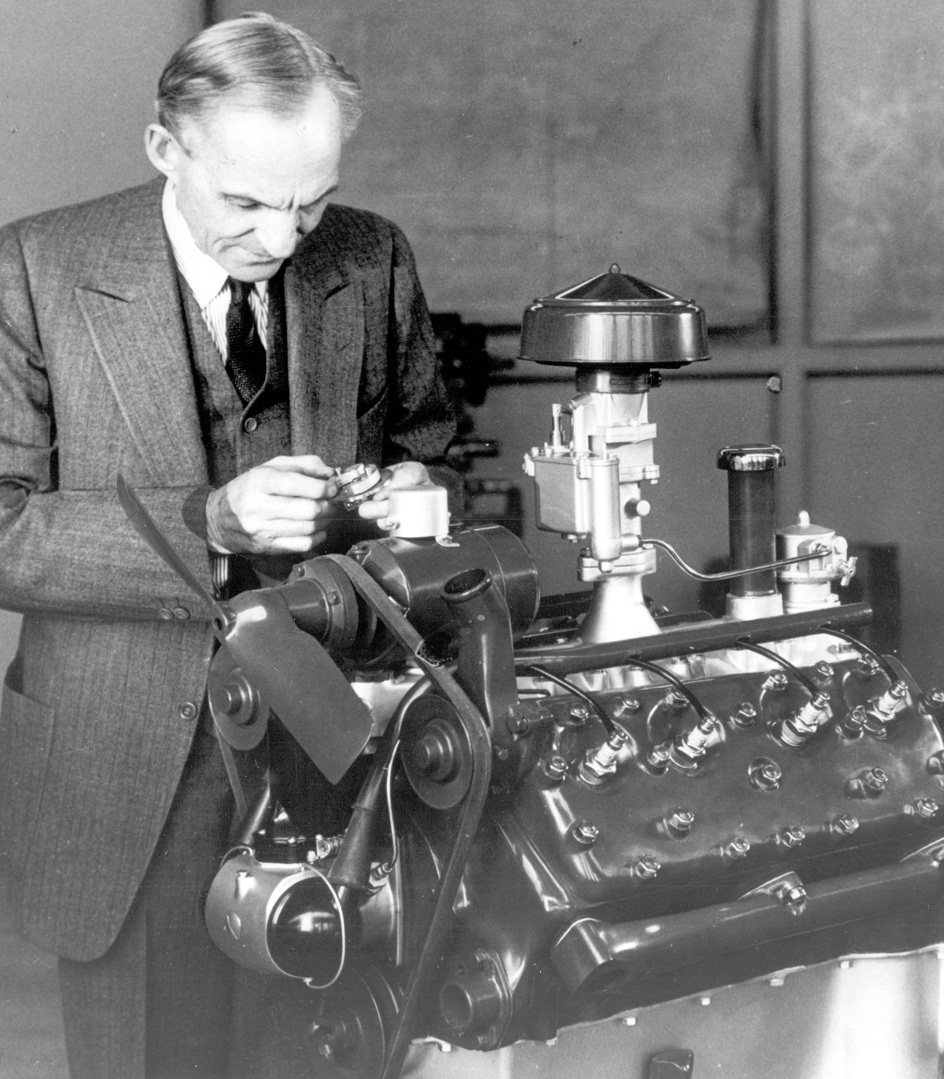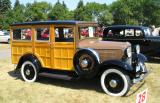|
|
|
|
#1 |
|
Senior Member
Join Date: May 2010
Location: Southern France
Posts: 5,837
|
For those who haven't seen it.
|
|
|

|
|
|
#2 |
|
Senior Member
Join Date: May 2015
Posts: 10,161
|
1932 Ford V-8 Engine, No. 1 Inscriptions Brass plate on side marked: THIS IS V-8 NO. 1 MOTOR / HOLD FOR MR. H. FORD Silver plate on carb: FORD / TYPE NO. / MODEL 51 / C32900 / PATENT NO. 178287 / V-8 / MFD BY / DETROIT LUBRICATOR COMPANY / DETROIT U.S.A. On sparkplugs: CHAMPION / FORD / REG. US. . PAT . OFF / MADE IN U.S.A. Specifications Make & Model: 1932 Ford V-8 engine Maker: Ford Motor Company, Dearborn, Michigan Engine: V-8, L-head valves, 221 cubic inches Horsepower: 65 at 3400 revolutions per minute Last edited by petehoovie; 08-07-2025 at 02:50 PM. |
|
|

|
| Sponsored Links (Register now to hide all advertisements) |
|
|
|
|
#3 |
|
Senior Member
Join Date: May 2010
Location: Southern France
Posts: 5,837
|
That was quick Pete ! Thanks !!
|
|
|

|
|
|
#4 |
|
Senior Member
Join Date: Jul 2010
Location: NorCal
Posts: 291
|
My cut-away 32 engine
|
|
|

|
|
|
#5 |
|
Senior Member
Join Date: May 2012
Location: Queensland, Australia
Posts: 12,016
|
|
|
|

|
|
|
#6 |
|
Senior Member
Join Date: May 2010
Location: southeastern Michigan
Posts: 10,601
|
Sponsored Links (Register now to hide all advertisements)
There were three V8 engines transferred from the engine plant on March 7th, #242, #243, and #244. According to engine plant log, #243 was selected to be 18-1. The last photo shows what is perhaps one of the first 241 engines that did not make the grade. One can only wonder what the thinking was behind locating the starter motor on top of the bell housing. How it ended up in the hands of the Henry Ford isn't clear, although a good bet is that it was removed from the Victoria chassis along with the other first 1,928 initial engines for major revisions and another engine and transmission took its place. That shown in Sheldon's photo was neglected for many years until Lynn Stringer (RIP), former Director of the Early Ford Club, received permission to clean it up and restore some parts of it that had gone missing over time. I had the privilege of supplying some of those parts. Last edited by DavidG; 08-07-2025 at 11:39 PM. |
|
|

|
|
|
#7 |
|
Senior Member
Join Date: May 2010
Location: Qld, Australia
Posts: 4,529
|
David, thanks for being the mine of info on these early fords.
Such important info. Lawrie |
|
|

|
|
|
#8 |
|
Senior Member
Join Date: Jan 2011
Location: Beverly Kansas
Posts: 5,302
|
Interesting to me, it has side mounts, like a B motor, and no rear mount for the K member. Early frames were like this?
|
|
|

|
|
|
#9 |
|
Senior Member
Join Date: May 2015
Posts: 10,161
|

|
|
|

|
|
|
#10 |
|
Senior Member
Join Date: May 2010
Location: southeastern Michigan
Posts: 10,601
|
If you mean the rubber/steel rear motor mount, it is just not installed. Note that motor mount is on the engine that pre-dates #1 (in the fourth photo).
The early engine blocks with separate steady rod brackets like a Model B are generally known as "flange" blocks. There were two versions of those V8 steady rod brackets, the first version using the same holes in the center cross member as the Model B and second having the same cross member hole spacing as with the cast-in stead rod holes in the blocks. Those so-called flange blocks had the oil dipstick hole on the right rear side in the block itself. It was soon changed to the left side as the right side was incompatible with the steering gear in RHD installations. |
|
|

|
|
|
#11 |
|
Senior Member
Join Date: May 2010
Location: southeastern Michigan
Posts: 10,601
|
Pete,
Yet another early engine, but with cylinder heads lacking the extra partrusions on the heads of #18-1. |
|
|

|
|
|
#12 |
|
Senior Member
Join Date: May 2015
Posts: 10,161
|
What's the story on this one?

|
|
|

|
|
|
#13 |
|
Senior Member
Join Date: Mar 2014
Location: Jacksonville FL
Posts: 4,807
|
David
Would it be "safe" to "theorize" that the "actual/true" 18-1 was lost to history? .......possibly 2 - 24o something as well?? |
|
|

|
|
|
#14 |
|
Senior Member
Join Date: Sep 2013
Location: SoCal-Redlands
Posts: 3,413
|
One of my cars and coffee buddies mentioned that the first Ford V8 was made in San Bernardino, CA. First I heard of it despite having lived in the area since 1966 so I pretty much figured it was just urban legend. But this thread lead me to this info so the story seems to have some truth to it. Not sure if the newspaper link will open but here is what Mr. Google says about it.
In 1917, in San Bernardino, California, a Ford dealer named J. Dale Gentry, along with engineer Martin Lewis, created a V8 engine by combining two Model T four-cylinder engines. This engine, known as the Gentry-Lewis V8, used a Model T crankshaft and custom connecting rods. Gentry initially intended to produce and sell these engines as performance upgrades for Model Ts, but Ford Motor Company intervened, forcing him to abandon the project to protect his dealership. https://www.pressenterprise.com/2013...irst-ford-v-8/
__________________
Making the simple complicated for over 30 years. |
|
|

|
|
|
#15 |
|
Senior Member
Join Date: May 2010
Location: southeastern Michigan
Posts: 10,601
|
Pete,
Ford worked on developing a vacuum-assisted clutch for the '32s, which in your photo appears to be for a RHD application. Attached is an archives photo of it on a Model B engine for a LHD application. Perhaps inspired by that feature on 1932 Lincolns. Its development reached the point of being patented, but was never released for production. Oddly, all '32 Ford firewalls have provision to mount that vacuum canister, |
|
|

|
|
|
#16 | |
|
Senior Member
Join Date: May 2015
Posts: 10,161
|
Quote:
|
|
|
|

|
|
|
#17 |
|
Senior Member
Join Date: Mar 2014
Location: Jacksonville FL
Posts: 4,807
|
David
I find it interesting that in Pete’s post 9 and 12 the exhaust manifolds are painted with block….OR painted along with the block before Installation…..hard to tell on Sheldon’s photo in post 1 |
|
|

|
|
|
#18 |
|
Senior Member
Join Date: May 2010
Location: southeastern Michigan
Posts: 10,601
|
Robert,
Likely you are right. It would be interesting to disassemble the engine at the Henry Ford to see if any of the internal modifications of the April recall were made. My guess is that they were not as one of the major changes was to eliminate the one-piece valve and tappet. I saw them myself when Lynn Stringer removed the intake manifold for cleaning. It is a super-early engine without a doubt, but is it 18-1,#252, 253, or 254? We will likely never know with absolute certainty. A little bit of mystery adds spice to the hobby. If some hyper-observant person notices that the Museum engine/transmission assembly does not have the earliest version of the shift lever housing, please recall that more than 30,000 Model B engine/transmission assemblies had already been manufactured before the Museum engine. Last edited by DavidG; 08-08-2025 at 07:36 PM. |
|
|

|
|
|
#19 |
|
Senior Member
Join Date: Jan 2012
Location: Lyman,ME.
Posts: 2,890
|
David, In your 4th photo of the engines right side, is the left exhaust crossover a cast piece that routes over the bell housing to the right side?….and it looks like the right side of the block only has the center outlet.Is the exhaust routed out the front and rear, up higher on the block than we’re used to. What is the other manifold looking object under the right exhaust manifold. I agree, not the best place for a starter but you could definitely hear it working inside the car and it might be easier to change.
I find these little bits of history on our favorite engines fascinating……Thank you…..Mark
__________________
I'm thinkin' about crankin' My ragged ol' truck up and haulin' myself into town. Billy Joe Shaver…RIP |
|
|

|
|
|
#20 |
|
Senior Member
Join Date: May 2010
Location: Southern France
Posts: 5,837
|
Pic in post #1 the manifolds appear raw.In post #9 since its a true display engine the manifolds appear porcelainized like the Lincoln Intakes.Notice in Post #9 what we or I called the elbow fuel inlet line fitting (at side of bowl facing rear) characteristic to the early carb.Later ,fuel arrived at the bottom.
|
|
|

|
 |
«
Previous Thread
|
Next Thread
»
|
|
| Sponsored Links (Register now to hide all advertisements) |
|
|
All times are GMT -5. The time now is 02:16 PM.














 Hybrid Mode
Hybrid Mode
